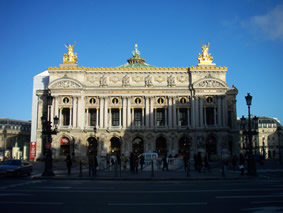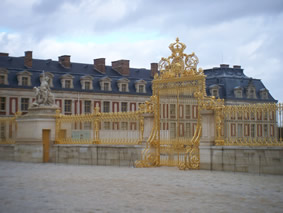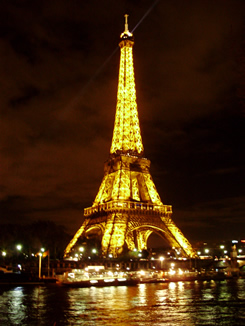Île de la Cité
Île de la Cité is probably the most iconic and quintessential heart of most people’s image of Paris, containing many monuments that define it as ‘Paris- Moyen Age’, or Paris in the Middle Ages. Île de la Cité, along with Île Saint-Louis, lie within the Seine, which itself divides the city into “La Rive Gauche” and “la Rive droite” or Left Bank and Right Bank. As the brilliant students as we all are, it took us some time before we could confidently identify which part of the city we were in throughout the 2 weeks we were there. Though some of us chose more circuitous routes, we all eventually met up with Vincent at the Metro stop Cité to begin our visit.
– Samiksha
Sainte-Chapelle

The Sainte-Chapelle was opening a little later today, and while we waited in the courtyard, Vincent recounted more of the history surrounding our visit. As he explained, in the predominantly Christian tradition of the Middle Ages, one of the main governing principles of the king was to lead his people closer to God and salvation (“conduire le peuple vers le paradis”). Louis IX (Saint-Louis–he was apparently canonized later) was understandably interested in purchasing relics of the Passion which the emperor of Constantinople (who needed military aid) offered, and later the Sainte-Chapelle was built to house these treasures.
As we saw in front us, the Sainte Chapelle has two levels, La Chapelle Basse which was for commoners and La Chapelle Haute, which was connected to the Palace (and now Palais de Justice) for the direct entry of the king and the royal family. We walked into La Chapelle Basse and my first impression was that of ‘chaleur’ (warmth) from the rich colors and textures of the walls and soaring arches . While the celebrated Couronne d’Epines (Christ’s Crown of Thorns) that Louis IX acquired now resides in Notre Dame, it is now devoid of thorns, because, as Vincent explained, they were distributed to other ruling monarchs around Europe to give a sign of legitimacy to their elite echelon in society.
We ascended the tiny spiraling staircase to La Chapelle Haute, and my concentration was firmly locked on trying not to trip and fall. As we reached the top of the stairs, I looked up, possibly tried to make an articulate sound, and failed. As clichéd as the expression is, the view literally took my breath away. Les vitraux, the towering, beautiful stained glass windows–thought to be one of the best of its type in the world–surrounded us like a giant kaleidoscope. It was also 20 degrees colder up here, probably because of the lack of any heating mechanism that could counter the heat loss through the windows and cold stone, and our attempts to see everything at once were punctuated by the tightening of scarves and gloves to stay warm.

Les Vitrails
The way to read each window, as we learned, is to start at the bottom left, move across, move up to the next level and read from right to left, move up again, reading left to right again in a sinuous pattern that told a story. We looked at 2 scenes in particular, “l’histoire de reliques de la Passion”, the story of how the Relics of the Passion were brought to France (which was the last panel and apparently included amongst the Biblical scenes to emphasize the Royal Family’s importance to the people) and “le livre de Judith”, the book of Judith. Red and blue are the dominant colors here, and Vincent explained how the use of certain colors on the various scenes carried symbolic connotations, especially in the Middle Ages.

Les Couleurs
- Rouge: la puissance- associée avec le sang et l’empereur romain
- Bleu : la sagesse, la joie, une valeur positive- associée avec la Vierge
- Jaune : la trahison
- Rayures : connotation très mal, le mélange de couleurs signifiait un coté diabolique
- Red : strength, association with the color of blood and the Roman emperors
- Blue : wisdom, joy, overall positive valor, associated with the Virgin Mary
- Yellow : treason, treacherousness
- Stripes : evil, the mixing of colours were supposedly a sign of a diabolical side
We could see now why red and blue were heavily favored here, and also by the royalty. As I read more about this symbolism later on, I learned that Louis IX, under the influence of the Church, required Jews to wear “une rouelle jaune”, a yellow circular badge, as a symbol of their supposed infamy, the same tactic reused by the Nazis with “l’etoile jaune”, the yellow star, to isolate and denigrate Jewish citizens.
Color has always been a strong symbol in cultures around the world, and while symbolism may vary, it was interesting to learn about these paradigms and their influence on art and history.
– Samiksha
Notre Dame

We also examined the main door which represents a scene of Judgment Day, with depictions of “paradis” (heaven) on the left and “enfers” (hell) on the right. The bottom represents dual pictures of vices and virtues , again in the vein of instructing the people through visual aids at a time when literacy was not widespread. I thought it was really interesting to see the melding of both form and function in the architecture of Sainte Chapelle as well as here at Notre Dame, which clearly resulted in something “intemporel”, as attested by the people who continue to visit in such large numbers.

-Samiksha
Palais de Justice

The Palais de Justice was built over Louis IX’s former palace and still remains connected to Sainte-Chapelle. We walked around to the imposing, main entrance of the Palais de Justice, which as Vincent explained, was designed to both impress and intimidate the various people passing through its gates. We witnessed the procession of judges leaving for a ceremonial function, dressed in their traditional robes. It was quite imposing to be in the same place where famous figures like Marie Antoinette were judged by the infamous Tribunal Revolutionaire, and sentenced to the guillotine during the “Terreur”.
– Samiksha
Sacre Coeur
So clear and serene. This église (Church), like the many others we visited, had a soothing and calm ambiance. There was no noise, no distraction, nothing to hinder the visitors from seeing this magnificent building representing a haven. Watching several people pray, others taking photos, many simply walking–people of all different ages and backgrounds, it provoked a feeling of simplicity and unity.
–Vasudha

This was my third time to the church, the first time when I was four years old, then when I was in high school, but somehow I never made it inside. I had heard that it was unimpressive within, so I was astonished by the magnificent golden Jesus and calm atmosphere of prayer within. I was also surprised to see that the church was built only about a hundred years ago, and that it remains very active to this day.
–Ashley
Opéra Garnier

On Sunday, January 17, for the first time after a week in Paris, the weather was great! We headed out to visit “Le Palais Garnier”, French for “Garnier’s Palace”. It was such a momentous sight as we emerged from the metro, met by the sight of the palatial opera house. Names of famous musicians were engraved on the wall above the entrance, and while I do not remember all the names, I do recall that “Mozart” was right at the center, surrounded by “Beethoven” and others. The inside of the building was likewise palatial in every sense, with staircases leading up to the audience sitting areas and balconies above the staircases just so that those walking up the staircases could be watched as they ascended! The highlight of the visit to the opera was when Sophie, our guide, pointed out the haunted “Loge 5”, home of the Phantom of the Opera. I do not know why, but rather than run away, we posed for pictures at the door.
–Beneah
Château de Versailles

The “Château de Versailles”, simply called the Palace of Versailles, is French royal palace established by Louis XIV. It was the epitome of wealth and to some extent showed that those who brand Loius XIV’s reign over France as the perfect example of absolutism did so correctly. From the king’s bedroom to the dauphin’s guest room, every room was glamorous and perfected with pomp and color. The palace gardens are expansive and decorated with the occasional statue of some historical figure or a water fountain.
–Beneah
Passages Couverts
On a chilly morning, Vincent guided us through the most notable covered passages, including Galerie Vivienne. These passages were initially created to give citizens a sheltered and delightful walk through the city, while permitting merchants to expose their products. Many are still used today, providing a charming look back in time and past tendencies in architecture and decor. For instance, we noted the use of mosaics made by the same artisan who decorated l’Opéra Garnier.
–Monica
Eiffel Tower

Everyone in the group loved the Eiffel tower, which attracted our lens-finder like a magnet. We especially loved how the tower would sparkle for five minutes every hour at night. Efrain and I had a discussion about whether we find the tower attractive only because we are tourists, and maybe it’s an eyesore for the natives. I asked Sophie about it, and she had a great response. “You never get used to beauty,” she said. “It’s very easy to get used to ugliness, but beauty, never.”
–Ashley
